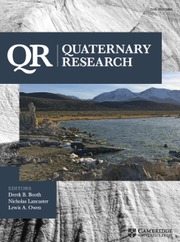Article contents
A 7600 yr vegetation and fire history from Anthony Lake, northeastern Oregon, USA, with linkages to modern synoptic climate patterns
Published online by Cambridge University Press: 10 January 2019
Abstract
We used pollen and high-resolution charcoal analysis of lake sediment to reconstruct a 7600 yr vegetation and fire history from Anthony Lake, located in the Blue Mountains of northeastern Oregon. From 7300 to 6300 cal yr BP, the forest was composed primarily of Populus, and fire was common, indicating warm, dry conditions. From 6300 to 3000 cal yr BP, Populus declined as Pinus and Picea increased in abundance and fire became less frequent, suggesting a shift to cooler, wetter conditions. From 3000 cal yr BP to present, modern-day forests composed of Pinus and Abies developed, and from 1650 cal yr BP to present, fires increased. We utilized the modern climate-analogue approach to explain the potential synoptic climatological processes associated with regional fire. The results indicate that years with high fire occurrence experience positive 500 mb height anomalies centered over the Great Basin, with anomalous southerly component of flow delivering dry air into the region and with associated sinking motions to further suppress precipitation. It is possible that such conditions became more common over the last 1650 cal yr BP, supporting an increase in fire despite the shift to more mesic conditions.
- Type
- Research Article
- Information
- Copyright
- Copyright © University of Washington. Published by Cambridge University Press, 2019
References
REFERENCES
- 6
- Cited by




